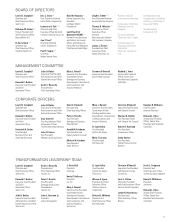E-Z-GO 2008 Annual Report Download - page 18
Download and view the complete annual report
Please find page 18 of the 2008 E-Z-GO annual report below. You can navigate through the pages in the report by either clicking on the pages listed below, or by using the keyword search tool below to find specific information within the annual report.
5
Textron Inc.
Backlog
Our backlog at the end of 2008 and 2007 is summarized below:
January 3, December 29,
(In millions) 2009 2007
U.S. Government:
Bell $ 5,037 $ 2,805
Textron Systems 2,242 2,092
Total U.S. Government backlog 7,279 4,897
Commercial:
Cessna 14,530 12,583
Bell 1,155 1,004
Other 310 391
Total Commercial backlog 15,995 13,978
Total backlog $ 23,274 $ 18,875
At January 3, 2009, approximately 99% of the U.S. Government backlog was funded. Unfunded backlog represents the award value of
U.S. Government contracts received, generally related to cost-plus type contracts, in excess of the funding formally appropriated by the
U.S. Government. The U.S. Government is obligated only up to the funded amount of the contract. Additional funding is appropriated as the
contract progresses.
Approximately 75% of our total backlog at January 3, 2009, represents orders that are not expected to be filled in 2009, including $1.4 billion in
orders for the new Citation CJ4 aircraft with first customer deliveries scheduled for 2010, and $2.3 billion in orders for the Citation Columbus
aircraft, which began development in 2008 and is not expected to provide significant revenues until the latter half of the next decade.
Cessna’s backlog includes approximately $1.5 billion in orders from a major fractional jet customer. Orders from this fractional aircraft operator
are included in backlog when the customer enters into a definitive master agreement and has established preliminary delivery dates for the
aircraft. Delivery dates are subject to change through amendment to the master agreement. Orders from other Cessna customers, which cover a
wide spectrum of industries worldwide, are included in backlog when the customer enters into a definitive purchase order. An initial customer
deposit is required upon entering into a definitive purchase agreement with subsequent additional deposits at certain milestone dates. Orders
remain in backlog until the aircraft is delivered or the customer requests cancellation. Upon cancellation, deposits are used to defray costs
including remarketing fees, cost to reconfigure the aircraft and other costs incurred as a result of the cancellation. Remaining deposits, if any, may
be refunded at our discretion.
The deepening recession and turmoil in the capital markets have significantly impacted many of our customers during the second half of 2008.
As a result, a significant number of Cessna’s customers have requested deferral of their scheduled jet delivery date, transition to a smaller or less
expensive jet model, or in some cases, to cancel their order. We also identified customers interested in accelerating their aircraft delivery date to
replace deferrals or cancellations. As a result, we have lowered our planned jet production level for 2009. We expect ongoing volatility in the
timing of fulfillment of our Cessna backlog until economic conditions stabilize.
U.S. Government Contracts
In 2008, approximately 24% of our consolidated revenues were generated by or resulted from contracts with the U.S. Government. This business
is subject to competition, changes in procurement policies and regulations, the continuing availability of funding, which is dependent upon
congressional appropriations, national and international priorities for defense spending, world events, and the size and timing of programs in
which we may participate.
Our contracts with the U.S. Government generally may be terminated by the U.S. Government for convenience or if we default in whole or in part
by failing to perform under the terms of the applicable contract. If the U.S. Government terminates a contract for convenience, we normally will be
entitled to payment for the cost of contract work performed before the effective date of termination, including, if applicable, reasonable profit on
such work, as well as reasonable termination costs. If, however, the U.S. Government terminates a contract for default, generally: (a) we will be
paid the contract price for completed supplies delivered and accepted, an agreed-upon amount for manufacturing materials delivered and
accepted and for the protection and preservation of property, and for partially completed products accepted by the U.S. Government; (b) the U.S.
Government will not be liable for our costs with respect to unaccepted items and will be entitled to repayment of advance payments and progress
























